stop start MAZDA MODEL CX-5 2013 (in English) Owner's Manual
[x] Cancel search | Manufacturer: MAZDA, Model Year: 2013, Model line: MODEL CX-5, Model: MAZDA MODEL CX-5 2013Pages: 488, PDF Size: 8.75 MB
Page 151 of 488
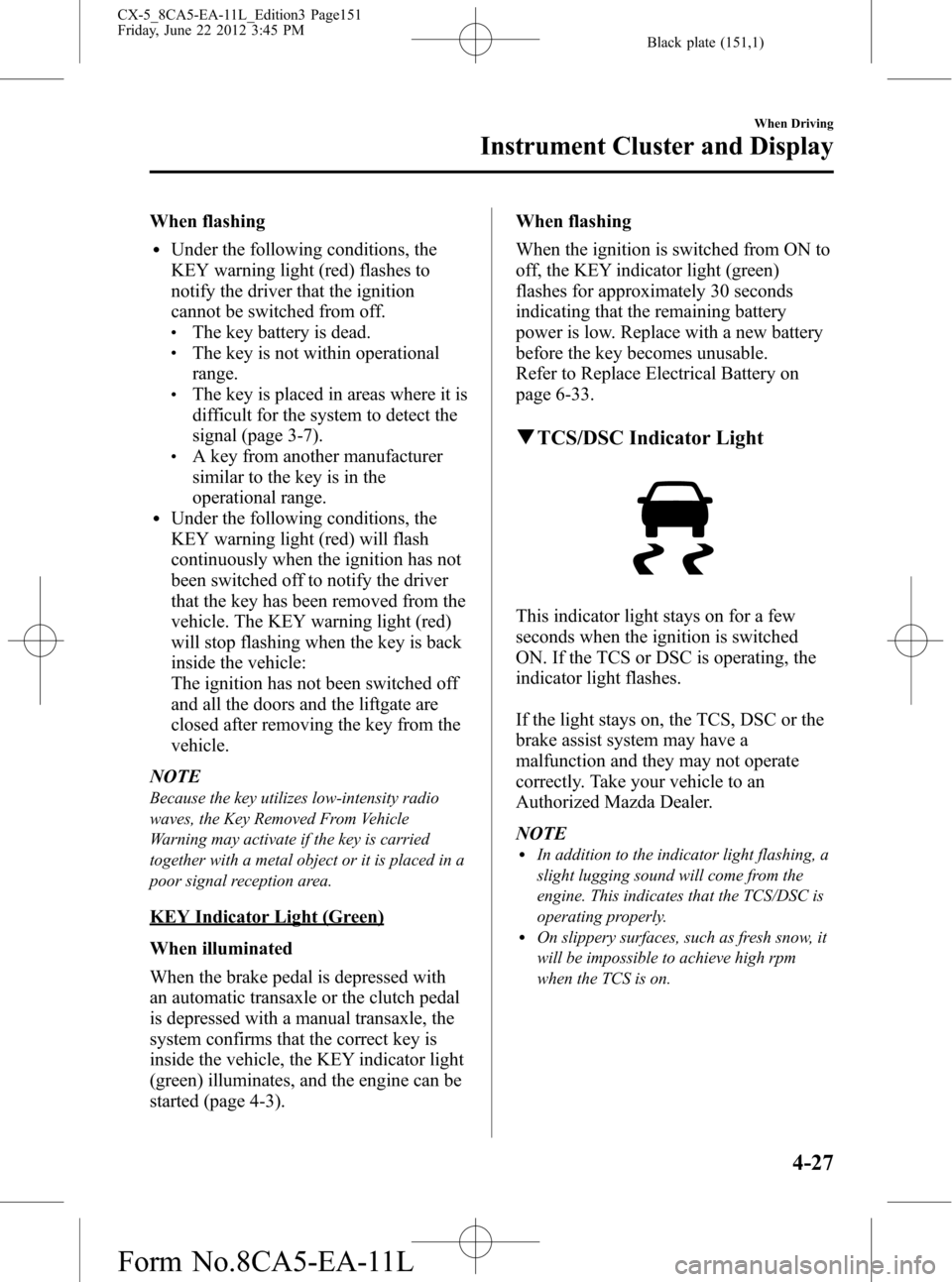
Black plate (151,1)
When flashing
lUnder the following conditions, the
KEY warning light (red) flashes to
notify the driver that the ignition
cannot be switched from off.
lThe key battery is dead.lThe key is not within operational
range.
lThe key is placed in areas where it is
difficult for the system to detect the
signal (page 3-7).
lA key from another manufacturer
similar to the key is in the
operational range.
lUnder the following conditions, the
KEY warning light (red) will flash
continuously when the ignition has not
been switched off to notify the driver
that the key has been removed from the
vehicle. The KEY warning light (red)
will stop flashing when the key is back
inside the vehicle:
The ignition has not been switched off
and all the doors and the liftgate are
closed after removing the key from the
vehicle.
NOTE
Because the key utilizes low-intensity radio
waves, the Key Removed From Vehicle
Warning may activate if the key is carried
together with a metal object or it is placed in a
poor signal reception area.
KEY Indicator Light (Green)
When illuminated
When the brake pedal is depressed with
an automatic transaxle or the clutch pedal
is depressed with a manual transaxle, the
system confirms that the correct key is
inside the vehicle, the KEY indicator light
(green) illuminates, and the engine can be
started (page 4-3).When flashing
When the ignition is switched from ON to
off, the KEY indicator light (green)
flashes for approximately 30 seconds
indicating that the remaining battery
power is low. Replace with a new battery
before the key becomes unusable.
Refer to Replace Electrical Battery on
page 6-33.
qTCS/DSC Indicator Light
This indicator light stays on for a few
seconds when the ignition is switched
ON. If the TCS or DSC is operating, the
indicator light flashes.
If the light stays on, the TCS, DSC or the
brake assist system may have a
malfunction and they may not operate
correctly. Take your vehicle to an
Authorized Mazda Dealer.
NOTE
lIn addition to the indicator light flashing, a
slight lugging sound will come from the
engine. This indicates that the TCS/DSC is
operating properly.
lOn slippery surfaces, such as fresh snow, it
will be impossible to achieve high rpm
when the TCS is on.
When Driving
Instrument Cluster and Display
4-27
CX-5_8CA5-EA-11L_Edition3 Page151
Friday, June 22 2012 3:45 PM
Form No.8CA5-EA-11L
Page 153 of 488
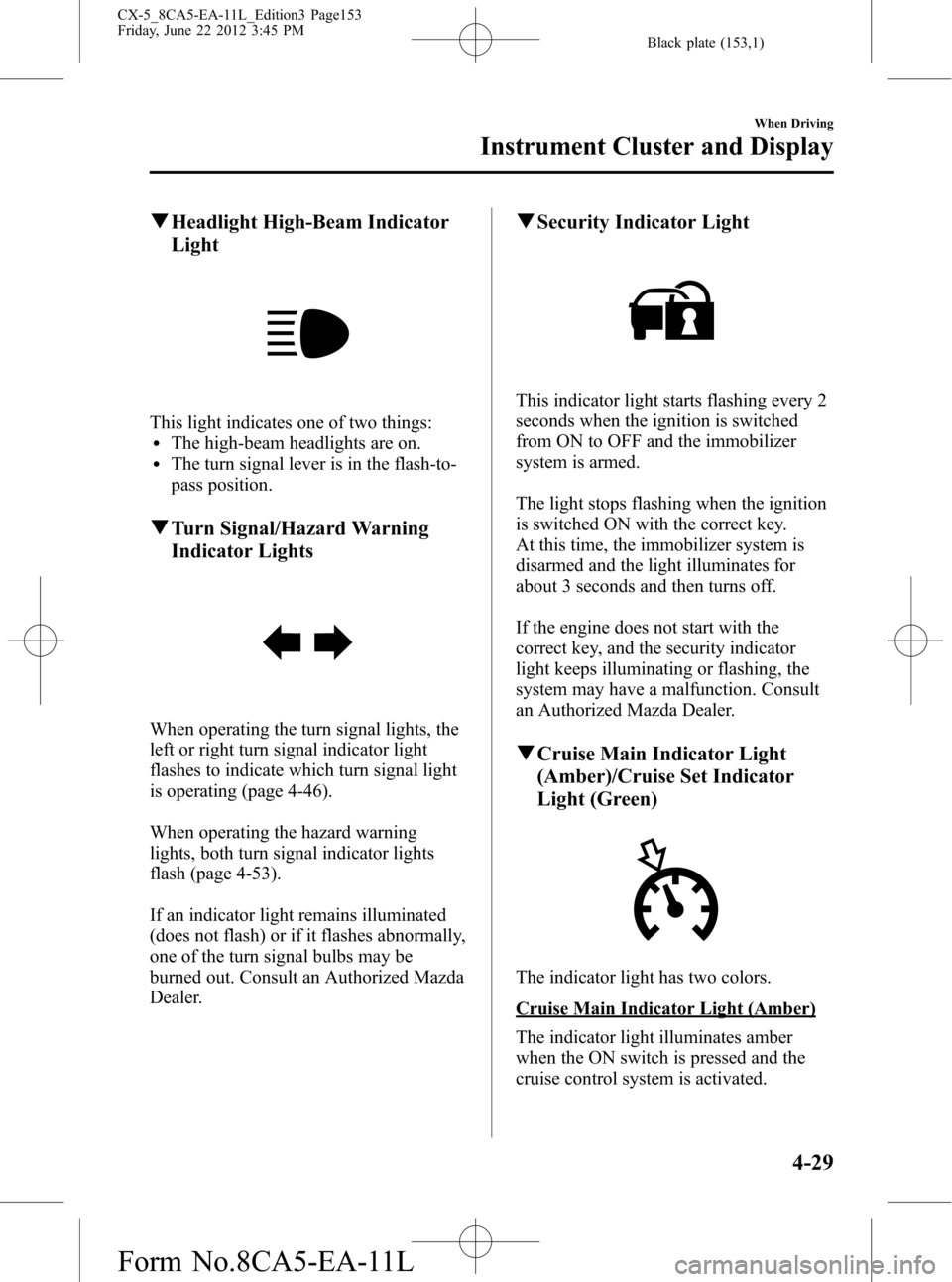
Black plate (153,1)
qHeadlight High-Beam Indicator
Light
This light indicates one of two things:lThe high-beam headlights are on.lThe turn signal lever is in the flash-to-
pass position.
qTurn Signal/Hazard Warning
Indicator Lights
When operating the turn signal lights, the
left or right turn signal indicator light
flashes to indicate which turn signal light
is operating (page 4-46).
When operating the hazard warning
lights, both turn signal indicator lights
flash (page 4-53).
If an indicator light remains illuminated
(does not flash) or if it flashes abnormally,
one of the turn signal bulbs may be
burned out. Consult an Authorized Mazda
Dealer.
qSecurity Indicator Light
This indicator light starts flashing every 2
seconds when the ignition is switched
from ON to OFF and the immobilizer
system is armed.
The light stops flashing when the ignition
is switched ON with the correct key.
At this time, the immobilizer system is
disarmed and the light illuminates for
about 3 seconds and then turns off.
If the engine does not start with the
correct key, and the security indicator
light keeps illuminating or flashing, the
system may have a malfunction. Consult
an Authorized Mazda Dealer.
qCruise Main Indicator Light
(Amber)/Cruise Set Indicator
Light (Green)
The indicator light has two colors.
Cruise Main Indicator Light (Amber)
The indicator light illuminates amber
when the ON switch is pressed and the
cruise control system is activated.
When Driving
Instrument Cluster and Display
4-29
CX-5_8CA5-EA-11L_Edition3 Page153
Friday, June 22 2012 3:45 PM
Form No.8CA5-EA-11L
Page 158 of 488

Black plate (158,1)
qWarning Light
A system malfunction or operation
conditions are indicated by a warning.
Refer to Warning/Indicator Lights on page
4-15.
qTransaxle Ranges
lThe shift position indicator light in the
instrument cluster illuminates.
Refer to Warning/Indicator Lights on
page 4-15.
lThe shift lever must be in P or N to
operate the starter.
P (Park)
P locks the transaxle and prevents the
front wheels from rotating.
WARNING
Always set the shift lever to P and set
the parking brake:
Only setting the shift lever to the P
position without using the parking
brake to hold the vehicle is
dangerous. If P fails to hold, the
vehicle could move and cause an
accident.
CAUTION
ØShifting into P, N or R while the
vehicle is moving can damage
your transaxle.
ØShifting into a driving gear or
reverse when the engine is running
faster than idle can damage the
transaxle.
R (Reverse)
In position R, the vehicle moves only
backward. You must be at a complete stop
before shifting to or from R, except under
rare circumstances as explained in
Rocking the Vehicle (page 3-41).
N (Neutral)
In N, the wheels and transaxle are not
locked. The vehicle will roll freely even
on the slightest incline unless the parking
brake or brakes are on.
WARNING
If the engine is running faster than idle,
do not shift from N or P into a driving
gear:
It's dangerous to shift from N or P
into a driving gear when the engine
is running faster than idle. If this is
done, the vehicle could move
suddenly, causing an accident or
serious injury.
Do not shift into N when driving the
vehicle:
Shifting into N while driving is
dangerous. Engine braking cannot be
applied when decelerating which
could lead to an accident or serious
injury.
CAUTION
Do not shift into N when driving the
vehicle. Doing so can cause transaxle
damage.
NOTE
Apply the parking brake or depress the brake
pedal before moving the shift lever from N to
prevent the vehicle from moving unexpectedly.
4-34
When Driving
Transaxle
CX-5_8CA5-EA-11L_Edition3 Page158
Friday, June 22 2012 3:45 PM
Form No.8CA5-EA-11L
Page 159 of 488

Black plate (159,1)
D (Drive)
D is the normal driving position. From a
stop, the transaxle will automatically shift
through a 6-gear sequence.
M (Manual)
M is the manual shift mode position.
Gears can be shifted up or down by
operating the shift lever.
Refer to Manual Shift Mode (page 4-36).
qActive Adaptive Shift (AAS)
Active Adaptive Shift (AAS)
automatically controls the transaxle shift
points to best suit the road conditions and
driver input. This improves driving
comfort.
The transaxle may switch to AAS mode
when driving up and down slopes,
cornering, or depressing the accelerator
pedal quickly while the shift lever is in the
D position.
Depending on the driving conditions and
vehicle operations, it may not be possible
to shift gears, however, this does not
indicate a problem because the AAS
mode will maintain the optimum gear
position.
qShift-Lock System
The shift-lock system prevents shifting
out of P unless the brake pedal is
depressed.
To shift from P:
1. Depress and hold the brake pedal.
2. Start the engine.
3. Move the shift lever.NOTE
lWhen the ignition is switched to ACC or the
ignition is switched off, the shift lever
cannot be shifted from P.
lThe ignition cannot be switched to OFF if
the shift lever is not in P.
qShift-Lock Override
If the shift lever will not move from P
using the proper shift procedure, continue
to hold down the pedal.
1. Remove the shift-lock override cover
using a cloth-wrapped flat head
screwdriver.
2. Insert a screwdriver and push it down.
Cover
3. Move the shift lever.
4. Take the vehicle to an Authorized
Mazda Dealer to have the system
checked.
When Driving
Transaxle
4-35
CX-5_8CA5-EA-11L_Edition3 Page159
Friday, June 22 2012 3:45 PM
Form No.8CA5-EA-11L
Page 162 of 488

Black plate (162,1)
Second gear fixed mode
When the shift lever is tapped back (
)
while the vehicle is stopped or driven at
about 9.3 km/h (5.7 mph) or less, the
transaxle is set in the second gear fixed
mode. The gear is fixed in second while in
this mode for easier starting and driving
on slippery roads. If the shift lever is
tapped back (
) or forward () while in
the second gear fixed mode, the mode will
be canceled.
Shifting specification
Shifting up
If the vehicle speed is lower than the
speed specified for each gear, the gear
cannot be shifted up to a higher gear.
Gear Vehicle speed
M1→M2 9.3 km/h (5.8 mph)
M2→M3 22.5 km/h (14.0 mph)
M3→M4 31.2 km/h (19.4 mph)
M4→M5 43.8 km/h (27.3 mph)
M5→M6 53.5 km/h (33.3 mph)
Shifting down
If the vehicle speed is higher than the
speed specified for each gear, the gear
cannot be shifted to a lower gear so as to
protect the transaxle.
Gear Vehicle speed
M6→M5 237.5 km/h (147.5 mph)
M5→M4 167.3 km/h (103.9 mph)
M4→M3 115.2 km/h (71.58 mph)
M3→M2 81.3 km/h (50.5 mph)
M2→M1 42.7 km/h (26.5 mph)
NOTE
Regarding the vehicle speed at the highest
gear indicated above, achieving this speed
may not actually be possible depending on
various driving conditions such as the wind,
upslope, and road surface.
During deceleration, the gears shift down
automatically when speed is reduced to
the following:
Gear Vehicle speed
M6→M5 47 km/h (29 mph)
M5→M4 39.8 km/h (24.7 mph)
M4→M3 28.2 km/h (17.5 mph)
M3→M2 11.9 km/h (7.39 mph)
M2→M1 6.3 km/h (3.9 mph)
NOTE
The gear does not shift down to M1
automatically while in the second gear fixed
mode.
If the vehicle is kicked down at the
following speeds or lower, the gears shift
down automatically:
Gear Vehicle speed
M6→M5 216.1 km/h (134.2 mph)
M5→M4 139.3 km/h (86.5 mph)
M4→M3 57.6 km/h (35.7 mph)
M3→M2 41.4 km/h (25.7 mph)
Recommendations for shifting (U.S.A.
and Canada)
Upshifting
For normal acceleration and cruising, we
recommend these shift points.
Gear Vehicle speed
M1 to M2 24 km/h (15 mph)
M2 to M3 40 km/h (25 mph)
M3 to M4 65 km/h (40 mph)
M4 to M5 73 km/h (45 mph)
M5 to M6 81 km/h (50 mph)
Downshifting
When you must slow down in heavy
traffic or on a steepupgrade, downshift
before the engine starts to overwork. This
gives better acceleration when you need
more speed.
4-38
When Driving
Transaxle
CX-5_8CA5-EA-11L_Edition3 Page162
Friday, June 22 2012 3:45 PM
Form No.8CA5-EA-11L
Page 184 of 488
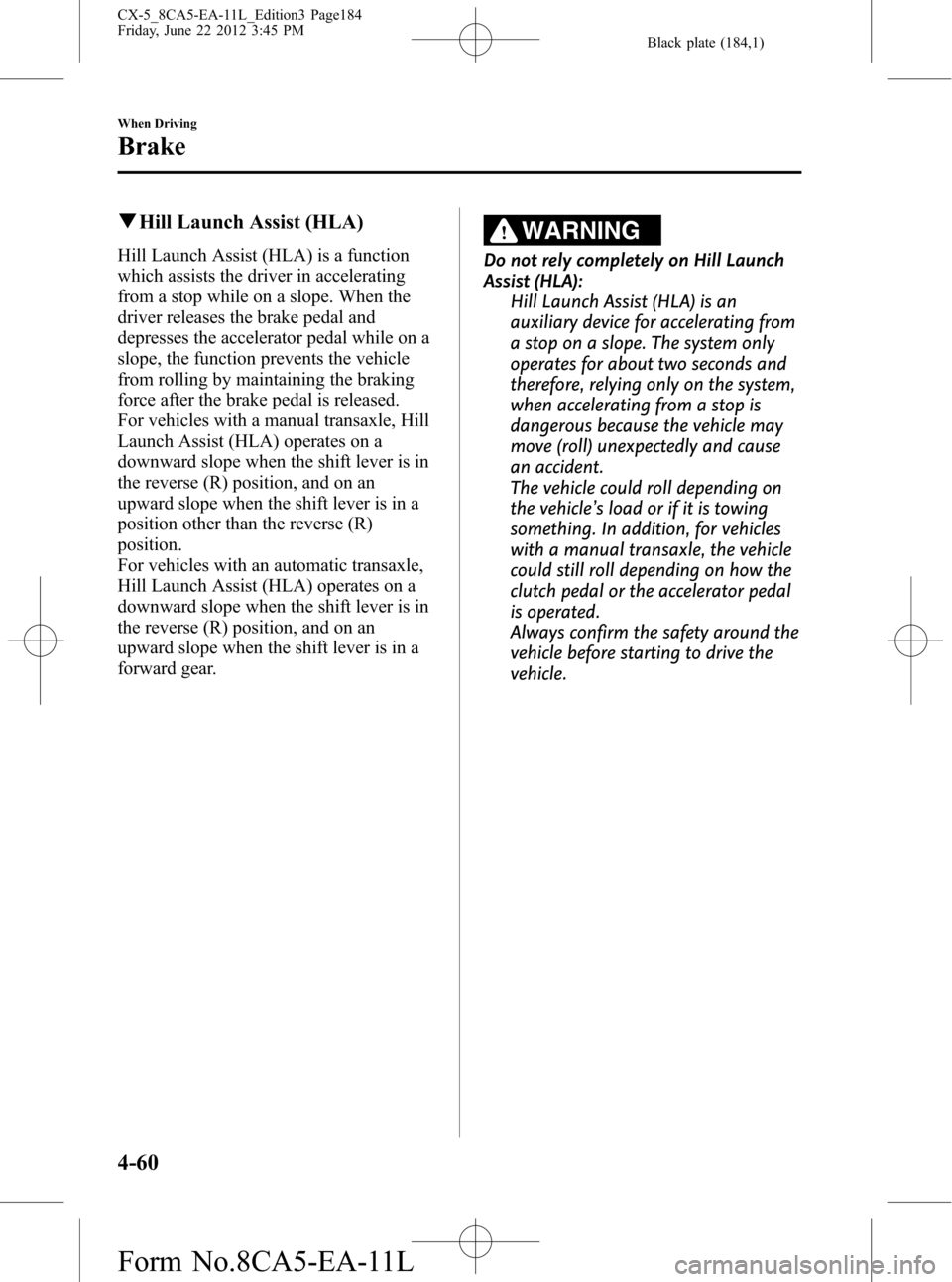
Black plate (184,1)
qHill Launch Assist (HLA)
Hill Launch Assist (HLA) is a function
which assists the driver in accelerating
from a stop while on a slope. When the
driver releases the brake pedal and
depresses the accelerator pedal while on a
slope, the function prevents the vehicle
from rolling by maintaining the braking
force after the brake pedal is released.
For vehicles with a manual transaxle, Hill
Launch Assist (HLA) operates on a
downward slope when the shift lever is in
the reverse (R) position, and on an
upward slope when the shift lever is in a
position other than the reverse (R)
position.
For vehicles with an automatic transaxle,
Hill Launch Assist (HLA) operates on a
downward slope when the shift lever is in
the reverse (R) position, and on an
upward slope when the shift lever is in a
forward gear.
WARNING
Do not rely completely on Hill Launch
Assist (HLA):
Hill Launch Assist (HLA) is an
auxiliary device for accelerating from
a stop on a slope. The system only
operates for about two seconds and
therefore, relying only on the system,
when accelerating from a stop is
dangerous because the vehicle may
move (roll) unexpectedly and cause
an accident.
The vehicle could roll depending on
the vehicle’s load or if it is towing
something. In addition, for vehicles
with a manual transaxle, the vehicle
could still roll depending on how the
clutch pedal or the accelerator pedal
is operated.
Always confirm the safety around the
vehicle before starting to drive the
vehicle.
4-60
When Driving
Brake
CX-5_8CA5-EA-11L_Edition3 Page184
Friday, June 22 2012 3:45 PM
Form No.8CA5-EA-11L
Page 186 of 488
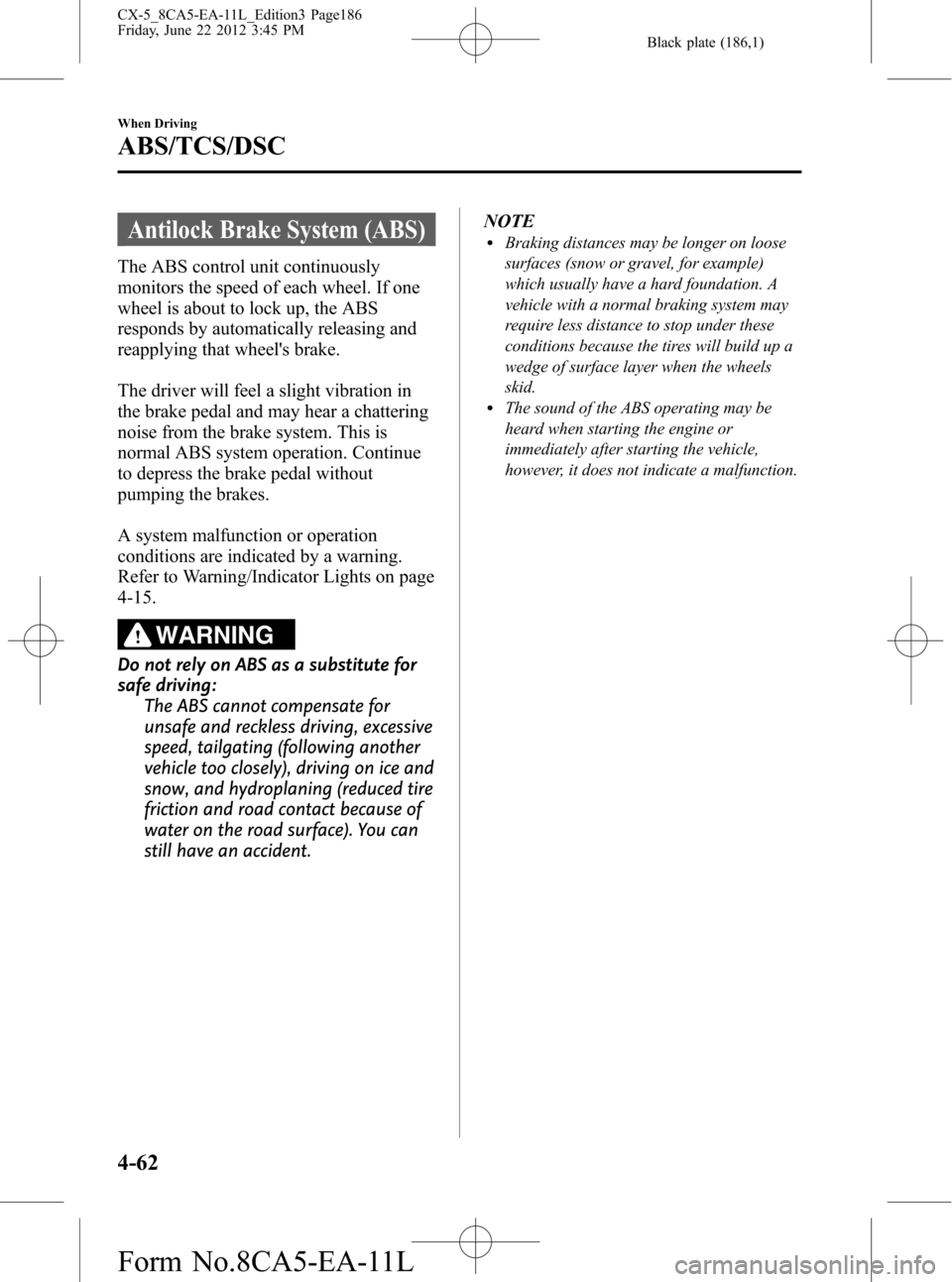
Black plate (186,1)
Antilock Brake System (ABS)
The ABS control unit continuously
monitors the speed of each wheel. If one
wheel is about to lock up, the ABS
responds by automatically releasing and
reapplying that wheel's brake.
The driver will feel a slight vibration in
the brake pedal and may hear a chattering
noise from the brake system. This is
normal ABS system operation. Continue
to depress the brake pedal without
pumping the brakes.
A system malfunction or operation
conditions are indicated by a warning.
Refer to Warning/Indicator Lights on page
4-15.
WARNING
Do not rely on ABS as a substitute for
safe driving:
The ABS cannot compensate for
unsafe and reckless driving, excessive
speed, tailgating (following another
vehicle too closely), driving on ice and
snow, and hydroplaning (reduced tire
friction and road contact because of
water on the road surface). You can
still have an accident.NOTE
lBraking distances may be longer on loose
surfaces (snow or gravel, for example)
which usually have a hard foundation. A
vehicle with a normal braking system may
require less distance to stop under these
conditions because the tires will build up a
wedge of surface layer when the wheels
skid.
lThe sound of the ABS operating may be
heard when starting the engine or
immediately after starting the vehicle,
however, it does not indicate a malfunction.
4-62
When Driving
ABS/TCS/DSC
CX-5_8CA5-EA-11L_Edition3 Page186
Friday, June 22 2012 3:45 PM
Form No.8CA5-EA-11L
Page 196 of 488
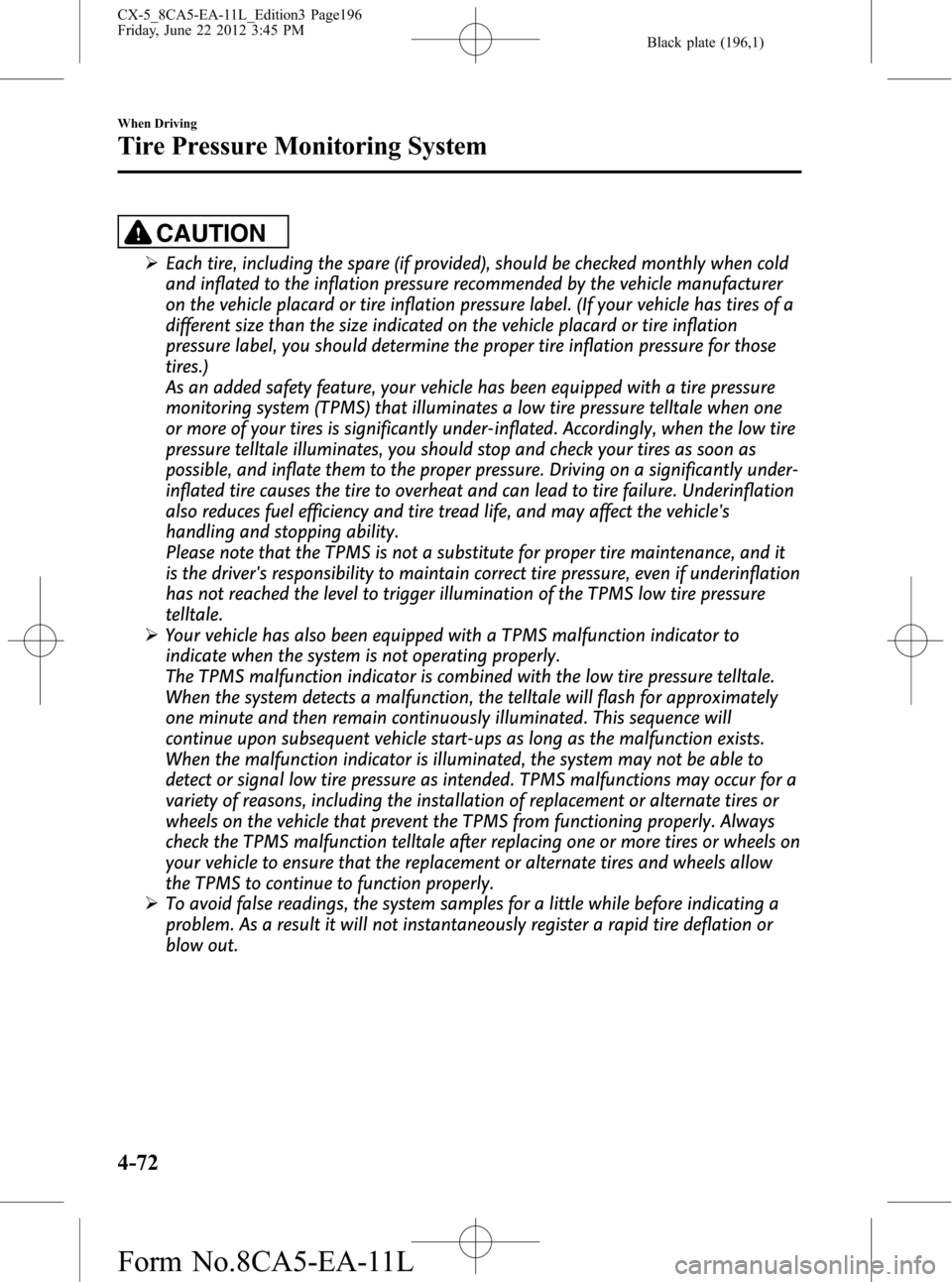
Black plate (196,1)
CAUTION
ØEach tire, including the spare (if provided), should be checked monthly when cold
and inflated to the inflation pressure recommended by the vehicle manufacturer
on the vehicle placard or tire inflation pressure label. (If your vehicle has tires of a
different size than the size indicated on the vehicle placard or tire inflation
pressure label, you should determine the proper tire inflation pressure for those
tires.)
As an added safety feature, your vehicle has been equipped with a tire pressure
monitoring system (TPMS) that illuminates a low tire pressure telltale when one
or more of your tires is significantly under-inflated. Accordingly, when the low tire
pressure telltale illuminates, you should stop and check your tires as soon as
possible, and inflate them to the proper pressure. Driving on a significantly under-
inflated tire causes the tire to overheat and can lead to tire failure. Underinflation
also reduces fuel efficiency and tire tread life, and may affect the vehicle's
handling and stopping ability.
Please note that the TPMS is not a substitute for proper tire maintenance, and it
is the driver's responsibility to maintain correct tire pressure, even if underinflation
has not reached the level to trigger illumination of the TPMS low tire pressure
telltale.
ØYour vehicle has also been equipped with a TPMS malfunction indicator to
indicate when the system is not operating properly.
The TPMS malfunction indicator is combined with the low tire pressure telltale.
When the system detects a malfunction, the telltale will flash for approximately
one minute and then remain continuously illuminated. This sequence will
continue upon subsequent vehicle start-ups as long as the malfunction exists.
When the malfunction indicator is illuminated, the system may not be able to
detect or signal low tire pressure as intended. TPMS malfunctions may occur for a
variety of reasons, including the installation of replacement or alternate tires or
wheels on the vehicle that prevent the TPMS from functioning properly. Always
check the TPMS malfunction telltale after replacing one or more tires or wheels on
your vehicle to ensure that the replacement or alternate tires and wheels allow
the TPMS to continue to function properly.
ØTo avoid false readings, the system samples for a little while before indicating a
problem. As a result it will not instantaneously register a rapid tire deflation or
blow out.
4-72
When Driving
Tire Pressure Monitoring System
CX-5_8CA5-EA-11L_Edition3 Page196
Friday, June 22 2012 3:45 PM
Form No.8CA5-EA-11L
Page 303 of 488

Black plate (303,1)
3. Press the audio button () and
then touch the
on-screen tab to
switch to the Bluetooth®audio mode
and start playback.
NOTE
lIf the Bluetooth®audio device does not
begin playback, press the
on-screen
button.
lIf the mode is switched from Bluetooth®
audio mode to another mode (radio mode),
audio playback from the Bluetooth®audio
device stops.
Playback
1. To listen to a Bluetooth
®audio device
over the vehicle's speaker system,
switch the mode to Bluetooth
®audio
mode. (Refer to“Switching to
Bluetooth
®audio mode”)
2. To stop playback, press the
on-
screen button.
3. Press the button again to resume
playback.
Selecting a file (track)
Selects the next file (track)
Short-press the track up button (
)or
touch the
on-screen button.
Selects the beginning of the current file
(track)
Short-press the track down button (
)or
touch the
on-screen button.
Fast-forward/Reverse (AVRCP Ver. 1.3
or higher)
Fast-forward
Press and hold the fast-forward button
(
) or touch and hold theon-
screen button.Reverse
Press and hold the reverse down button
(
) or touch and hold theon-
screen button.
Folder search (only AVRCP Ver. 1.4)
To change to the previous folder, touch
the
on-screen button, or touch the
on-screen button to advance to the
next folder.
Music scan (only AVRCP Ver. 1.4)
This function scans the titles in a folder
currently being played and plays 10
seconds of each song to aid you in finding
a song you want to listen to.
1. Touch the
on-screen button
during playback to play 10 seconds of
each subsequent track starting from the
next song.
2. Touch the
on-screen button again
during playback of the song which you
want to listen to continue the playback
from that point.
Repeat playback (only AVRCP Ver. 1.4)
Track repeat
Touch the
on-screen button to play
the song during playback repeatedly.“
”
is displayed during playback.
Touch the
on-screen button two
times while“
”is displayed to cancel.
Folder repeat
Touch the
on-screen button two
times to play the songs in the folder
repeatedly.“
”is displayed during
playback.
Touch the
on-screen button while
“
”is displayed to cancel.
Interior Features
Bluetooth®
5-89
CX-5_8CA5-EA-11L_Edition3 Page303
Friday, June 22 2012 3:47 PM
Form No.8CA5-EA-11L
Page 307 of 488

Black plate (307,1)
Voice recognition related problems
Symptom Cause Solution method
Poor voice recognition
lExcessive, slow speech.lExcessive, forceful speech
(shouting).
lSpeaking before the beep sound
has ended.
lLoud noise
(speaking or noise from outside/
inside vehicle).
lAirflow from A/C is blowing
against the microphone.
lSpeaking in off-standard
expressions (dialect).Regarding the causes indicated on
the left, be careful with how you
speak. In addition, when numbers are
spoken in a sequence, recognition
ability will improve if no stop is
placed between the numbers. False recognition of numbers
Names in the phonebook are not
easily recognizedThe Bluetooth
®system is under a
condition in which recognition is
difficult.By carrying out the following
measures, the rate of recognition will
improve.
lClear memory from the
phonebook which is not used
very often.
lAvoid shortened names, use full
names.
(Recognition improves the longer
the name is. By not using names
such as“Mom”,“Dad”, recogni-
tion will improve.)
You want to skip guidance
―Guidance can be skipped by quickly
pressing and releasing the Talk
button.
When the Talk button is pressed,
voice recognition endsIs the Talk button being held pressed
for too long?Operate the Talk button as follows:
lPress the button and release it
within 0.7 seconds to start voice
recognition and skip the
guidance.
lPress the button for longer than
0.7 seconds to turn off voice
recognition or end a
conversation.
Regarding problems with calls
Symptom Cause Solution method
When starting a call, vehicle noise
from the other party can be heardFor about three seconds after starting
a call, the Bluetooth
®unit's Noise
Suppression function requires time to
adapt to the call environment.This does not indicate a problem
with the device.
The other party cannot be heard or
the speaker's voice is quietIs the volume set at zero or low? Increase the volume.
Interior Features
Bluetooth®
5-93
CX-5_8CA5-EA-11L_Edition3 Page307
Friday, June 22 2012 3:47 PM
Form No.8CA5-EA-11L